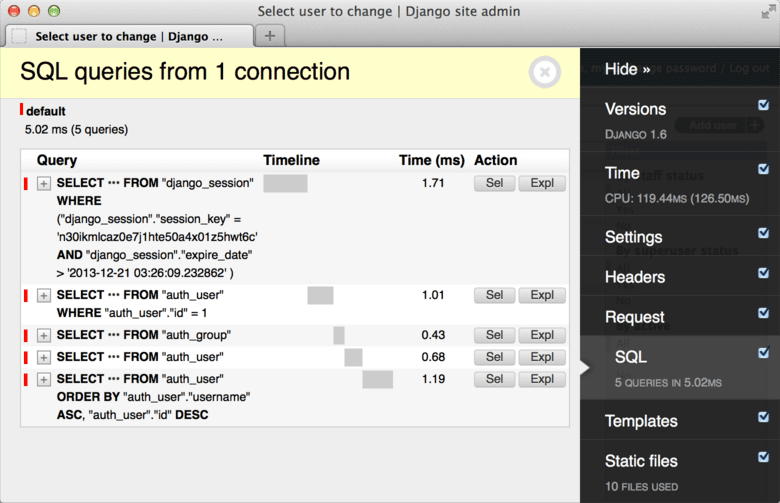Hello Coders,
This article presents a short-list with popular Django modules and apps that might help Python programmers to code faster new features by reusing some valuable work provided by open-source enthusiasts.
Thank you! Content provided by AppSeed - App Generator.
The list is built based on my personal experience and suggestions published by developers across relevant communities: Dev.to Pythoners / Django, Reddit Django and Python channels, and the classic Python Forum.
What is Django (web framework)
Short-Note for beginners - Django is an open-source web application framework written in Python. A framework means a collection of modules and helpers that make development easier. They are logically grouped together and allow you to create web applications by reusing stuff, instead of writing all from scratch.
Useful Django Resources:
- Django - official website and docs
- Django - related content provided by the (popular) Full-Stack-Python platform
The Short-List
- Django Extensions - a collection of custom extensions
- Django REST framework - a flexible toolkit for building Web APIs
- Drf-Yasg - Swagger Docs Generator for Django REST Framework
- Django Debug Toolbar - display various debug information for the current request
- Django CORS Headers - adds Cross-Origin Resource Sharing (CORS) headers to responses
- Django reCaptcha v3 - the integration of Google reCaptcha v3 in Django
- Django-environ - allows configuring Django apps with environment variables with ease
- Redis cache - Full-featured Redis cache backend for Django.
- Django Storages - a collection of custom storage backends for Django: Amazon S3, Azure, Digital Ocean, Dropbox.
- Django Allauth - Integrated set of Django apps addressing authentication, registration, account management as well as 3rd party (social) account authentication.
In case you want to test quickly any extension presented here, by updating some open-source projects, here is a shortlist with Django free applications
- Django Atlantis Dark - source code, MIT license
- Django Light Blue - source code, MIT license
- Django Dashboard Black - source code, MIT license
- Django Dashboard Shards - source code, MIT license
- Django Dashboard Material - source code, MIT license
Django Extensions
This is an open-source collection of custom extensions used for Django projects, released under the MIT license.
How to use it
$ pip install django-extensions
Enable the extensions in Django configuration (settings.py):
INSTALLED_APPS = (
...
'django_extensions',
...
)
Now we can use the magic via manage.py master script:
$ # Generate (and view) a graphviz graph of app models:
$ python manage.py graph_models -a -o myapp_models.png
$
$ # Check templates for rendering errors:
$ python manage.py validate_templates
$
$ # Run the enhanced django shell:
$ python manage.py shell_plus
Django REST framework
Django REST framework is a powerful and flexible toolkit for building Web APIs with an impressive feature set:
- The Web browsable API is a huge usability win for your developers.
- Authentication policies including packages for OAuth1a and OAuth2.
- Serialization that supports both ORM and non-ORM data sources.
Django REST Links:
- Homepage and quickstart docs
- Starter Sample Tutorial
Django Debug Toolbar
The Django Debug Toolbar is a configurable set of panels that display various debug information about the current request/response and when clicked, display more details about the panel's content.
Django CORS Headers
A Django App that adds Cross-Origin Resource Sharing (CORS) headers to responses. This allows in-browser requests to your Django application from other origins.
How to use it
$ pip install django-cors-headers
Add the extension in Django configuration:
INSTALLED_APPS = [
...
'corsheaders',
...
]
You will also need to add a middleware class to listen in on responses:
MIDDLEWARE = [ # Or MIDDLEWARE_CLASSES on Django < 1.10
...
'corsheaders.middleware.CorsMiddleware',
'django.middleware.common.CommonMiddleware',
...
]
Django reCaptcha v3
This integration app implements a ReCaptcha field for Google reCaptcha v3.
How to use it
$ pip install django-recaptcha3
Then add django-recaptcha3 to your installed apps:
INSTALLED_APPS = (
...
'snowpenguin.django.recaptcha3',
...
)
Update settings.py with reCaptcha private and public key:
RECAPTCHA_PRIVATE_KEY = 'Super_s3Cret_1234'
RECAPTCHA_PUBLIC_KEY = 'Public key'
Usage in Forms
from snowpenguin.django.recaptcha3.fields import ReCaptchaField
class ExampleForm(forms.Form):
[...]
captcha = ReCaptchaField()
[...]
Drf-Yasg
Swagger/OpenAPI Documentation Generator for Django REST Framework.
How to use it
$ pip install -U drf-yasg
Update the settings.py to enable the app:
INSTALLED_APPS = [
...
'drf_yasg',
...
]
Update urls.py:
...
from rest_framework import permissions
from drf_yasg.views import get_schema_view
from drf_yasg import openapi
...
schema_view = get_schema_view(
openapi.Info(
title="Snippets API",
default_version='v1',
description="Test description",
terms_of_service="https://www.google.com/policies/terms/",
contact=openapi.Contact(email="contact@snippets.local"),
license=openapi.License(name="BSD License"),
),
public=True,
permission_classes=(permissions.AllowAny,),
)
urlpatterns = [
url(r'^swagger(?P<format>\.json|\.yaml)$', schema_view.without_ui(cache_timeout=0), name='schema-json'),
url(r'^swagger/$', schema_view.with_ui('swagger', cache_timeout=0), name='schema-swagger-ui'),
url(r'^redoc/$', schema_view.with_ui('redoc', cache_timeout=0), name='schema-redoc'),
...
]
These simple settings will expose 4 endpoints:
- A JSON view of your API specification at /swagger.json
- A YAML view of your API specification at /swagger.yaml
- A swagger-ui view of your API specification at /swagger/
- A ReDoc view of your API specification at /redoc/
Django-environ
Django-environ allows you to use Twelve-factor methodology to configure your Django application with environment variables.
How to use it
$ pip install django-environ
Create an .env file in the root of your Django project (sample below):
DEBUG=on
SECRET_KEY=your-secret-key
DATABASE_URL=psql://urser:un-githubbedpassword@127.0.0.1:8458/database
SQLITE_URL=sqlite:///my-local-sqlite.db
Usage in Django Application (No need to add it to INSTALLED_APPS)
import environ
env = environ.Env(
# set casting, default value
DEBUG=(bool, False)
)
# reading .env file
environ.Env.read_env()
# False if not in os.environ
DEBUG = env('DEBUG')
# Raises django's ImproperlyConfigured exception if SECRET_KEY not in os.environ
SECRET_KEY = env('SECRET_KEY')
# Parse database connection url strings like psql://user:pass@127.0.0.1:8458/db
DATABASES = {
# read os.environ['DATABASE_URL'] and raises ImproperlyConfigured exception if not found
'default': env.db(),
# read os.environ['SQLITE_URL']
'extra': env.db('SQLITE_URL', default='sqlite:////tmp/my-tmp-sqlite.db')
}
Thank you!









Top comments (4)
Hi,
Didn't know about those admin packages, i use Django for 3 year now, thanks for sharing this. Seem like to use them i need to start a whole new project with them as project template.
Yw & Happy Coding!
The swagger package listed is being deprecated I think. You may want to check out pypi.org/project/drf-yasg/
Thank you! I will update the links :)